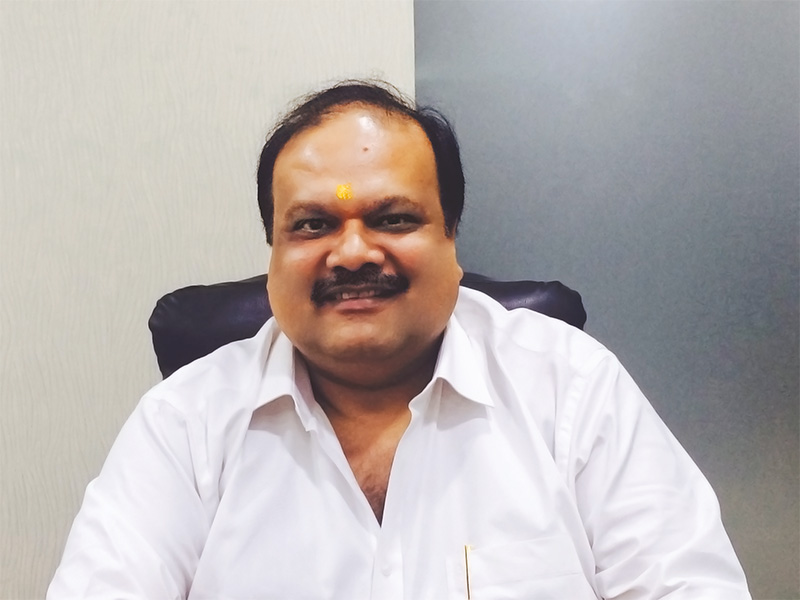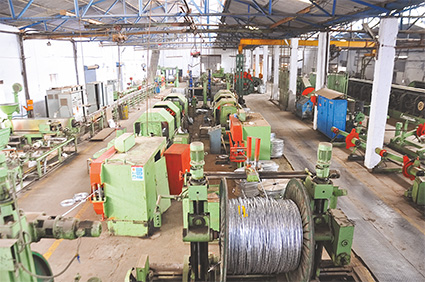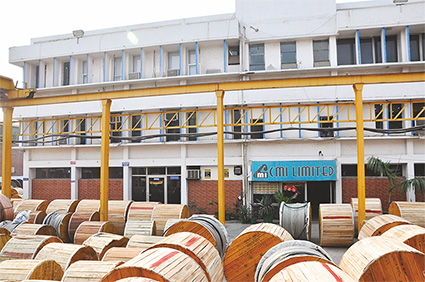With constantly improving balance sheet, inflating range of products, and two notable acquisitions in recent past, CMI seems set for its bon voyage in the growing wire and cable industry.

Incorporated in 1967, CMI initially was engaged in copper metal trade and copper melting and rod casting. In 1980, the company started manufacturing PVC Switch Board Cables, Control Cables, Screened Cables, FRLS Cables, and Data Transmission Cables etc. and later on diversified into manufacturing Polythylene Insulated Jelly Filled Telephone Cables. CMI Ltd. has been an acknowledged supplier to various customers including DoT (Aerial Cables, Drop Wire, and Switch Board Cables etc), Defence, Railways and other projects – both in private and public sectors. Today, CMI Ltd. produces an exhaustive range of wires and cables aimed at various industries and their specialized cabling needs.
The company was not doing very well until 2002 when it was acquired by its new promoters who breathed new life into it by applying strict financial discipline, production timeline and product innovation. As a result, CMI Ltd. not only positioned itself in the market viably, but also started looking bullish in its balance sheets so much so that it recently acquired two companies in succession – manufacturing facility of Danish company FL Smidth at Bawal, Haryana in September 2015 and the facility of General Cables Energy India Pvt. Ltd., a fully owned subsidiary of General Cable Corporation (GCC) in November 2015.
Wire & Cable India recently had a chance to undergo a detailed conversation with Mr. Amit Jain, CMD, CMI Ltd. where he discussed in detail about the company, its commitments on product and innovations, and the expectations from new acquisitions. Excerpts:
Wire & Cable India: After the acquisition of CMI in 2002 by its current promoters, the company has taken a sort of rebirth, transforming itself from being sick to becoming commercially viable and bullish. What was wrong in erstwhile sick company which the current owners corrected and how did they make it what it’s today?

Amit Jain: We acquired CMI Ltd in 2002. In the last 13 years, the company has not just come out of the red, but is also registering cash profits. From Rs. 5.6 Cr revenues in 2004-05, the company closed 2014-15 with revenues of Rs. 137.28 Cr.
The reasons why the company went sick before we took over is not something we would like to deliberate on. We suspect it was mostly because of not keeping strict controls on incomes and outgo. We firmly believe that we need to have financial controls in place as well as keep a hawk’s eye on our production and timelines.
The reason we have been able to make a difference is because we have been ensuring that we stay ahead of the technology curve by pumping money into the R&D and we have innovated new products, keeping in mind the customer requirements.
WCI: CMI, today, produces a large array of specialty cable aimed at important segments like infrastructure, railways, petrochemicals, etc. Tell us about the products you make and how you make them keeping the requirement of the diverse segments you cater.
AJ: There are more than hundreds types of cables that we have developed and have the capability to manufacture. Some of our mainstays in cables include Quad cables – Specialized Safety cables used by Railways for counting incoming & out going axles/coaches; Railway Signaling cables for transmitting signal to signal posts; Ballise cables for Train Protection & Warning system.
We also produce Fire Survival cables which are used to maintain circuit integrity in case of fire for 3 hrs up to 950 deg C; Low Smoke Zero Halogen cables that ensure better visibility & low toxicity in case of fire; Highly flexible multi core copper shielded abrasion resistant TPU sheathed cables that are used for Gas Insulated Substations.
The product range also includes Multi pair PTFE insulated & sheathed shielded cables that are used for Multi Object Tracking RADAR by ISRO; PTFE insulated, silver platted copper conductor, multi pair data cables for high temperature applications used at satellite launching stations; Air field lighting cables used for fire detection & alert equipments; Field Bus/ Profibus cables to be used for fire detection & alert equipments.
And, the list goes on to include Special telecom cables for underground application; Polythene Insulated Jelly Filled telecom cables as per TEC specification; Cables for Power transmission & distribution to every industry & households; Specialised Instrumentation & Data shielded cables; EPR-CSP-PCP-Silicon insulated & sheathed, highly flexible, abrasion resistant cable; Linear heat sensing cables, etc.
WCI: Is there any new development on the product side?
AJ: CMI has plans to manufacture Over Head Traction cables i.e. Grooved Copper Conductor & Copper Cadmium Catenery wire for use in electric traction in Railways; the necessary plant and machinery for the same has been installed. We are also approaching RDSO for its approval. There will be huge demand of these wires as Indian Railways is poised for electrification of its tracks in big way. Out of 65000 kms of tracks only 28000 kms has been electrified so far. Not only this, there will be huge demand by different metros coming up in different cities.
CMI is also exploring the possibilities of manufacturing HT cables up to 66 KV and on account of major thrust on industrialization the demand of Power is to increase tremendously and hence power cables.
Looking at the government thrust to improve communication & data transmission, huge requirement of OFC cables is anticipated and CMI is working on the project to equip itself to manufacture these cables.
WCI: Recently, CMI has done an important acquisition as per the news. Tell us in detail about the acquisition and how you are going to harness this to add value to your already extensive product portfolio.
AJ: CMI Limited acquired the fully developed manufacturing facility of Danish company FL Smidth at Bawal, Haryana in September 2015. Spread over 11235 sq. yards with built up area of 67000 sq. ft., the facility is located in the Industrial area of IMT, Bawal and has all the necessary clearances and facilities for Industrial production. This facility is expected to significantly augment the production capacity of our company. We intend to start production in the new facility within this financial year.
In November 2015, we acquired the facility of General Cables Energy India Pvt. Ltd., a fully owned subsidiary of General Cable Corporation (GCC), a Fortune 500 company. With this acquisition, we have exponentially increased our manufacturing capabilities. Over the next few years, this acquisition has the potential of adding around Rs.1,000 Crore to our top-line.
With these two acquisitions, our plate is full and we need to get these facilities moving at its optimal levels before we look at anything else.
WCI: Do you expect any market expansion after the acquisition?
AJ: We believe that our market share will grow exponentially with these acquisitions and we will become an even more significant player in our categories of operation. We already manufacture a wide variety of cables and are a multiproduct company, manufacturing Special and super specialty cables for very special usage. We hope to also get into the non-specialty cable category shortly.
WCI: Do you have anything else in mind in terms of plant, or capacity expansion?
AJ: Right now we are not looking any expansion. We are focusing on putting our two new facilities into high gear within this financial year.
WCI: Your current involvement with technology up gradation, if any?
AJ: The technology being used by us is in house development over the period of decades. Currently, our plant and machinery are state-of-the-art and has been procured from reputed manufactures in India, or from abroad. Continuous improvement is being done to meet specific requirement of customers in construction/design of cables and to improve the production capacity, automating where ever possible.
We have various ISI certifications to ensure quality of cables as per BSI standards. Specific customer approvals have also been obtained from various customers and quality of cables is ensured as per their specifications. For example, our products have been tested and approved; and approval certificates given by RDSO ( for cables to be supplied to Railways), EIL ( for different cables being supplied to Oil, Petroleum & chemical Industries), BSNL-TEC ( PIJF-Telecom cables), NPCIL, NTPC, DMRC, BHEL ( its various units), ISRO ( cables for space applications), Steel plants, EPCC contractors, etc.
We are manufacturing cables strictly as per customer’s specifications. We have complete in house in process quality control system, inspecting and testing cables at different production stages as per our QAP ( Quality assurance plan) and customer’s QAP. The products manufactured are inspected for all relevant test requirements before dispatch. Customers also get their cables tested from their nominated inspection agencies at our works before dispatch of cables to their consignees.
We at CMI continuously keep ourselves updated with the development in the industry, in country, or abroad, and also with new requirements of the customer and keep producing cables as per customer requirements.
We are incurring approximately 2 percent on R&D activities including updating modernizing of plant and machinery and trying new raw materials.
WCI: Your views in general on the current state and future of the wire and cable industry? Please give your comment product-category wise (power, telecom, control, auto-mation, etc.), or segment wise (infra, power, railways, automotive, etc.).
AJ: In India, the size of the cable manufacturing industry is approx Rs. 60,000 Crore, out of which only around 35 percent is with the organized sector. In the organized sector, cables are produced with best/virgin raw materials as per specifications, duly tested during production at various stages and then the final product is tested again before dispatch, following all commercial rules and regulations of the government.

The industry in the unorganized sector is mainly focused on the in-house/ building wiring industry, where no quality control is followed. The reason is that the end user is also not aware of all quality requirements for cables; and mostly, the cost is the deciding factor for purchase. This sector also takes advantage of laxity of the persons supposed to be controlling or implementing government rules, regulations and policies.
The organized sector in the industry is almost at par with the global best practices. However, some Extra High voltage cables, or cables for other usages e.g. submarine, mineral insulated cables, cables for aircraft industry have yet not been developed in the country.
WCI: At last, anything else you wish to add to this conversation?
AJ: We are very bullish on the industry and hope to corner a sizeable part of the industry in the coming years.




